Related Research Articles

A dune is a landform composed of wind- or water-driven sand. It typically takes the form of a mound, ridge, or hill. An area with dunes is called a dune system or a dune complex. A large dune complex is called a dune field, while broad, flat regions covered with wind-swept sand or dunes, with little or no vegetation, are called ergs or sand seas. Dunes occur in different shapes and sizes, but most kinds of dunes are longer on the stoss (upflow) side, where the sand is pushed up the dune, and have a shorter slip face in the lee side. The valley or trough between dunes is called a dune slack.

Sediment is a naturally occurring material that is broken down by processes of weathering and erosion, and is subsequently transported by the action of wind, water, or ice or by the force of gravity acting on the particles. For example, sand and silt can be carried in suspension in river water and on reaching the sea bed deposited by sedimentation; if buried, they may eventually become sandstone and siltstone through lithification.
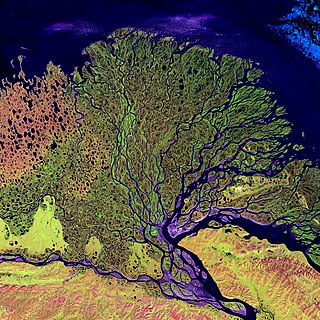
A river delta is a landform shaped like a triangle, created by the deposition of sediment that is carried by a river and enters slower-moving or stagnant water. This occurs at a river mouth, when it enters an ocean, sea, estuary, lake, reservoir, or another river that cannot carry away the supplied sediment. It is so named because its triangle shape resembles the uppercase Greek letter delta, Δ. The size and shape of a delta are controlled by the balance between watershed processes that supply sediment, and receiving basin processes that redistribute, sequester, and export that sediment. The size, geometry, and location of the receiving basin also plays an important role in delta evolution.

A salt marsh, saltmarsh or salting, also known as a coastal salt marsh or a tidal marsh, is a coastal ecosystem in the upper coastal intertidal zone between land and open saltwater or brackish water that is regularly flooded by the tides. It is dominated by dense stands of salt-tolerant plants such as herbs, grasses, or low shrubs. These plants are terrestrial in origin and are essential to the stability of the salt marsh in trapping and binding sediments. Salt marshes play a large role in the aquatic food web and the delivery of nutrients to coastal waters. They also support terrestrial animals and provide coastal protection.
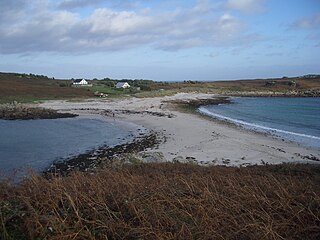
In oceanography, geomorphology, and geoscience, a shoal is a natural submerged ridge, bank, or bar that consists of, or is covered by, sand or other unconsolidated material, and rises from the bed of a body of water close to the surface or above it, which poses a danger to navigation. Shoals are also known as sandbanks, sandbars, or gravelbars. Two or more shoals that are either separated by shared troughs or interconnected by past or present sedimentary and hydrographic processes are referred to as a shoal complex.

Longshore drift from longshore current is a geological process that consists of the transportation of sediments along a coast parallel to the shoreline, which is dependent on the angle of incoming wave direction. Oblique incoming wind squeezes water along the coast, and so generates a water current which moves parallel to the coast. Longshore drift is simply the sediment moved by the longshore current. This current and sediment movement occur within the surf zone. The process is also known as littoral drift.

Barrier islands are a coastal landform—a type of dune system and sand island—where an area of sand has been formed by wave and tidal action parallel to the mainland coast. They usually occur in chains, consisting of anything from a few islands to more than a dozen. They are subject to change during storms and other action, but absorb energy and protect the coastlines and create areas of protected waters where wetlands may flourish. A barrier chain may extend for hundreds of kilometers, with islands periodically separated by tidal inlets. The largest barrier island in the world is Padre Island of Texas, United States, at 113 miles (182 km) long. Sometimes an important inlet may close permanently, transforming an island into a peninsula, thus creating a barrier peninsula, often including a beach, barrier beach. Though many are long and narrow, the length and width of barriers and overall morphology of barrier coasts are related to parameters including tidal range, wave energy, sediment supply, sea-level trends, and basement controls. The amount of vegetation on the barrier has a large impact on the height and evolution of the island.

Aeolian processes, also spelled eolian, pertain to wind activity in the study of geology and weather and specifically to the wind's ability to shape the surface of the Earth. Winds may erode, transport, and deposit materials and are effective agents in regions with sparse vegetation, a lack of soil moisture and a large supply of unconsolidated sediments. Although water is a much more powerful eroding force than wind, aeolian processes are important in arid environments such as deserts.
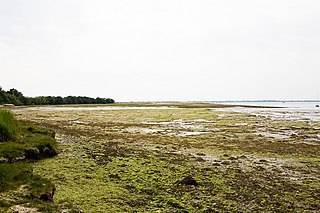
A tidal marsh is a marsh found along rivers, coasts and estuaries which floods and drains by the tidal movement of the adjacent estuary, sea or ocean. Tidal marshes experience many overlapping persistent cycles, including diurnal and semi-diurnal tides, day-night temperature fluctuations, spring-neap tides, seasonal vegetation growth and decay, upland runoff, decadal climate variations, and centennial to millennial trends in sea level and climate.
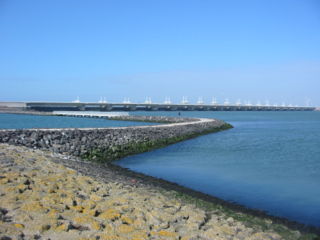
Coastal management is defence against flooding and erosion, and techniques that stop erosion to claim lands. Protection against rising sea levels in the 21st century is crucial, as sea level rise accelerates due to climate change. Changes in sea level damage beaches and coastal systems are expected to rise at an increasing rate, causing coastal sediments to be disturbed by tidal energy.
A chevron is a wedge-shaped sediment deposit observed on coastlines and continental interiors around the world. The term chevron was originally used independently by Maxwell and Haynes and Hearty and others for large, V-shaped, sub-linear to parabolic landforms in southwestern Egypt and on islands in the eastern, windward Bahamas.
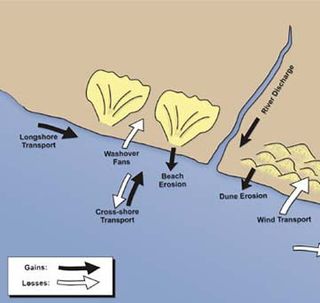
Sedimentary budgets are a coastal management tool used to analyze and describe the different sediment inputs (sources) and outputs (sinks) on the coasts, which is used to predict morphological change in any particular coastline over time. Within a coastal environment the rate of change of sediment is dependent on the amount of sediment brought into the system versus the amount of sediment that leaves the system. These inputs and outputs of sediment then equate to the total balance of the system and more than often reflect the amounts of erosion or accretion affecting the morphology of the coast.
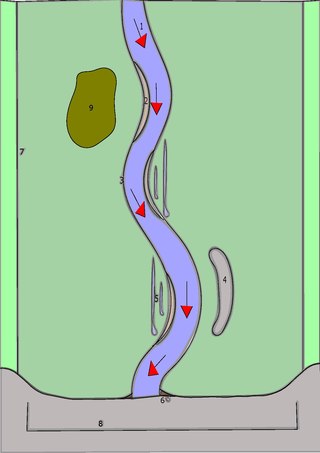
In geology, a backswamp is a type of depositional environment commonly found in a floodplain. It is where deposits of fine silts and clays settle after a flood. These deposits create a marsh-like landscape that is often poorly drained and usually lower than the rest of the floodplain.

A river mouth is where a river flows into a larger body of water, such as another river, a lake/reservoir, a bay/gulf, a sea, or an ocean. At the river mouth, sediments are often deposited due to the slowing of the current, reducing the carrying capacity of the water. The water from a river can enter the receiving body in a variety of different ways. The motion of a river is influenced by the relative density of the river compared to the receiving water, the rotation of the Earth, and any ambient motion in the receiving water, such as tides or seiches.
A mouth bar is an element of a deltaic system, which refers to the typically mid-channel deposition of the sediment transported by the river channel at the river mouth.
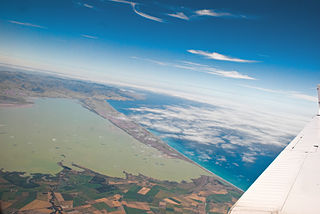
The Canterbury Bight is a large bight on the eastern side of New Zealand's South Island. The bight runs for approximately 135 kilometres (84 mi) from the southern end of Banks Peninsula to the settlement of Timaru and faces southeast, exposing it to high-energy storm waves originating in the Pacific Ocean. The bight is known for rough conditions as a result, with wave heights of over 2 metres (6.6 ft) common. Much of the bight's geography is shaped by this high-energy environment interacting with multiple large rivers which enter the Pacific in the bight, such as the Rakaia, Ashburton / Hakatere, and Rangitata Rivers. Sediment from these rivers, predominantly Greywacke, is deposited along the coast and extends up to 50 kilometres (31 mi) out to sea from the current shoreline. Multiple hapua, or river-mouth lagoons, can be found along the length of the bight where waves have deposited sufficient sediment to form a barrier across a river mouth, including most notably Lake Ellesmere / Te Waihora and Washdyke Lagoon
A coastal development hazard is something that affects the natural environment by human activities and products. As coasts become more developed, the vulnerability component of the equation increases as there is more value at risk to the hazard. The likelihood component of the equation also increases in terms of there being more value on the coast so a higher chance of hazardous situation occurring. Fundamentally humans create hazards with their presence. In a coastal example, erosion is a process that happens naturally on the Canterbury Bight as a part of the coastal geomorphology of the area and strong long shore currents. This process becomes a hazard when humans interact with that coastal environment by developing it and creating value in that area.

A tsunami deposit is a sedimentary unit deposited as the result of a tsunami. Such deposits may be left onshore during the inundation phase or offshore during the 'backwash' phase. Such deposits are used to identify past tsunami events and thereby better constrain estimates of both earthquake and tsunami hazards. There remain considerable problems, however, in distinguishing between deposits caused by tsunamis and those caused by storms or other sedimentary processes.

Paleotempestology is the study of past tropical cyclone activity by means of geological proxies as well as historical documentary records. The term was coined by American meteorologist Kerry Emanuel.
References
- ↑ Donnelly, C..; Kraus, N.; Larson, M. (2006). "State of knowledge on measurement and modeling of coastal overwash". Journal of Coastal Research. 22 (4): 965–991. doi:10.2112/04-0431.1. S2CID 131321011.
- ↑ Lorenzo-Trueba, Jorge; Ashton, Andrew D. (2014-04-01). "Rollover, drowning, and discontinuous retreat: Distinct modes of barrier response to sea-level rise arising from a simple morphodynamic model". Journal of Geophysical Research: Earth Surface. 119 (4): 2013JF002941. Bibcode:2014JGRF..119..779L. doi:10.1002/2013JF002941. hdl: 1912/6714 . ISSN 2169-9011. S2CID 54010731.
- ↑ Asbury H. Sallenger, Jr. (2000-01-01). "Storm Impact Scale for Barrier Islands". Journal of Coastal Research. 16 (3): 890–895. JSTOR 4300099.
- ↑ Lazarus, Eli D. (2016-12-16). "Scaling laws for coastal overwash morphology". Geophysical Research Letters. 43 (23): 12, 113–12, 119. Bibcode:2016GeoRL..4312113L. doi: 10.1002/2016GL071213 . ISSN 1944-8007.
- 1 2 Rogers, L.J..; Moore L. J.; Goldstein E. B.; Hein C. J.; Lorenzo-Trueba J.; Ashton A. D. (2015). "Anthropogenic controls on overwash deposition: Evidence and consequences". Journal of Geophysical Research: Earth Surface. 120 (12): 2609–2624. Bibcode:2015JGRF..120.2609R. doi: 10.1002/2015JF003634 . hdl: 1912/7946 .
- ↑ Shaw, J.; You, Y.; Mohrig, D.; Kocurek, G. (2015). "Tracking hurricane-generated storm surge with washover fan stratigraphy". Geology. 43 (2): 127–130. Bibcode:2015Geo....43..127S. doi:10.1130/g36460.1.
- ↑ Bregy, J. C.; Wallace, D. J.; Totten, R. L.; Cruz, V. J. (2018). "2500-year paleotempestological record of intense storms for the northern Gulf of Mexico, United States". Marine Geology. 396 (SI: Geological Records of Extreme Wave Events): 26–42. Bibcode:2018MGeol.396...26B. doi: 10.1016/j.margeo.2017.09.009 .
- ↑ Walters, David C.; Kirwan, Matthew L. (2016-05-01). "Optimal hurricane overwash thickness for maximizing marsh resilience to sea level rise". Ecology and Evolution. 6 (9): 2948–2956. doi:10.1002/ece3.2024. PMC 4808077 . PMID 27069590.
- ↑ Lazarus, E. D.; Armstrong, S. (2015). "Self-organized pattern formation in coastal barrier washover deposits" (PDF). Geology. 43 (4): 363–366. Bibcode:2015Geo....43..363L. doi:10.1130/g36329.1.